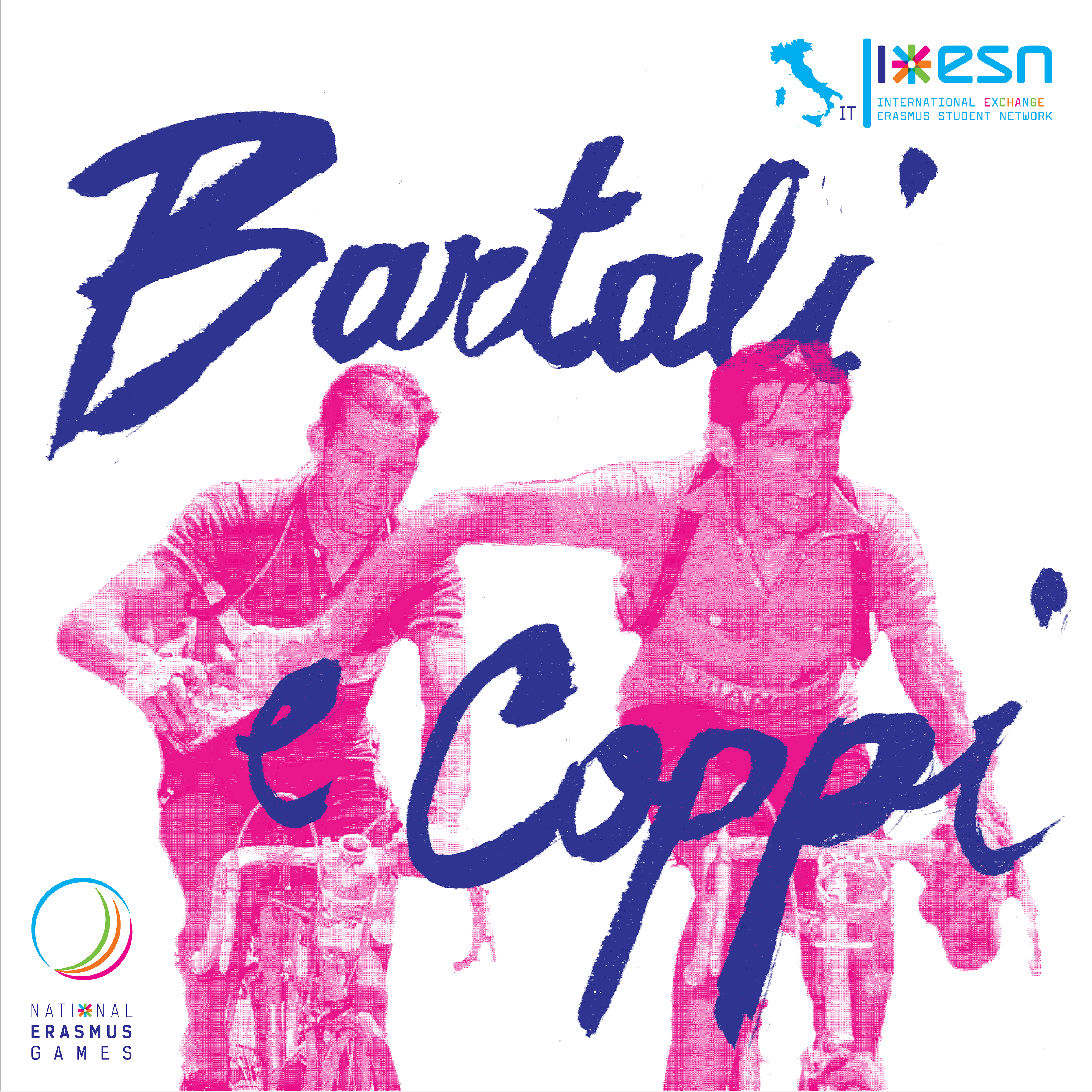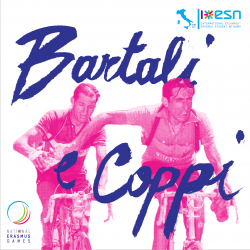[SCROLL DOWN FOR ENGLISH VERSION]
Siamo nel maggio 1940, si corre il Giro d’Italia. Gino Bartali è capitano della Legnano, è un ciclista esperto e navigato, ed è sulla buona strada per quello che in gergo viene chiamato ‘tris’, ovvero la vittoria per il terzo anno consecutivo nella stessa competizione. I suoi sogni di gloria, però, si sgretolano quando, in direzione di Genova, un cane gli taglia la strada e la caduta gli fa perdere dei minuti preziosi che gli precluderanno poi la vincita della maglia rosa.
Al suo posto, un giovane Fausto Coppi, reclutato dallo stesso Bartali, stacca i compagni e taglia il traguardo: mentre tutti osannano il nuovo campione, Bartali storce la bocca: “Chi va forte in pianura, paga dazio in montagna”.
E così fu. Sulle Dolomiti Coppi accusa la fatica, fino al punto di fermarsi e valutare il ritiro, ma Bartali, che ha un gran fiuto per il talento, lo sprona a tornare in sella e a continuare la gara, che poi porterà Coppi a vincere il suo primo Giro d’Italia.
La Seconda Guerra Mondiale divide le loro strade. Coppi viene mandato in Africa, dove viene fatto prigioniero dagli Inglesi. Dovrà aspettare il 1945 per rientrare in Italia e tornare in sella alla sua bici.
La bicicletta di Bartali, invece, non si ferma mai: a partire dall’autunno del ’43, nel periodo più buio e tragico della guerra, l’atleta usa i suoi allenamenti come escamotage per permettere la fuga dall’Italia fascista a più di 800 ebrei, nascondendo documenti falsi nel manubrio, nella canna e nel sellino della sua bici e macinando circa 350 chilometri al giorno, su e giù tra Assisi e Firenze. Ad essere a conoscenza delle sue azioni, solo il figlio Andrea, perché: “il bene si fa ma non si dice”.
Le vite dei due campioni tornano ad unirsi inevitabilmente durante il dopoguerra, dando vita ad una straordinaria rivalità sportiva, che degenera spesso in atteggiamenti antisportivi, come durante il campionato del mondo giocato nei Paesi Bassi (1948), quando i due si dimenticano di fare gioco di squadra e fanno di tutto per ostacolarsi a vicenda: subiscono il ritiro forzato dalla gara e vengono squalificati per un mese dalla Federazione.
Agli occhi degli Italiani, però, la competizione tra i due non si limita alle vicende sportive, ed acquista anzi un sapore politico: con le prime elezioni della neonata Repubblica Italiana, Coppi e Bartali diventano gli emblemi dei due principali partiti in lizza, il Partito Comunista Italiano - impersonato da Coppi, laico e dalle ispirazioni socialiste - e la Democrazia Cristiana - rappresentata da Bartali, con la sua devozione e i suoi riti legati alla tradizione popolare.
È nel 1952 che la loro rivalità fa la storia dello sport: costretti a tornare a gareggiare sotto la stessa bandiera per il Tour de France, vengono immortalati da un fotografo durante lo scambio di una borraccia mentre scalano i tornanti del Col du Galibier. La foto non lascia intendere chi dei due stia passando la borraccia all’altro, e se da un lato il mistero divise le tifoserie dei due atleti, che non vollero mai svelare la realtà dei fatti, dall’altro contribuì a rendere la foto un’icona, il simbolo di una nazione spaccata negli ideali, che però tende il braccio verso l’unità, mettendo da parte i conflitti personali in favore della stima e del rispetto reciproco.
----------------------------------------------------------------------------------------------------------------------------------------------------------------
Coppi and Bartali: the rivalry that brought a Nation together
It’s May 1940, during Giro d’Italia. Gino Bartali is captain of the Legnano team, he’s an experienced cyclist and he’s on his way to what they call a ‘tris’: winning the same competition for the third year in a row. His dreams of glory, though, suddenly crumble when approaching Genoa, a dog cuts him off, and the fall has him lose precious minutes that will preclude him from winning Pink Jersey.
In his place, a young Fausto Coppi, recruited by Bartali himself, leaves his teammates behind and crosses the finish line: while everyone cheers the new champion, a grimace shows on Bartali’s face: “The ones going strong in plain, pay duty on the mountains”.
And so it happened. On the Dolomites, Coppi is fatigued to the point of getting off of his bike and thinking about giving up, but Bartali, that knows raw talent when he sees it, challenges him to get back on track and finish the race. Following this advice will help Coppi win his first Giro d’Italia.
Second World War comes between them. Coppi is sent to Africa, where he’s taken captive by the English army. He will have to wait until 1945 to return to Italy and get back on his bike.
Bartali’s bike, on the contrary, never stops: from autumn of ’43, in the darkest and most tragic time of the war, the athlete makes use of his training to help more than 800 Jews escape fascist Italy, hiding counterfeit papers inside the handlebar, body and saddle of his bike and riding for more than 350km a day, up and down between Assisi and Florence. The only one to know about his act of heroism is his son Andrea, because: “you do good but you don’t talk about it”.
The lives of the two champions are inevitably brought back together after the war, giving life to an extraordinary rivalry, that often degenerates in unsportsmanlike actions, as happened during the World Championship competed in the Netherlands (1948), when the two forgot about team play and did anything they could to get in the way of each other: they are forced to retire from the race and the Federation disqualifies them for a whole month from competing.
To the eyes of Italian spectators, however, the rivalry between the two is not only on sports grounds, but it also earns a bit of a political taste: with the first elections ever held for the new-born Italian Republic, Coppi and Bartali become the emblems of the two major parties, the Partito Comunista Italiano – embodied by Coppi, laic and with a socialist disposition – and the Democrazia Cristiana – depicted by Bartali, with his devotion and his rituals linked to popular traditions.
It’s in 1952 that their rivalry makes history: forced to go back to race in the same team for Tour de France, a photographer immortalises them passing a water bottle back and forth between them while climbing Col du Galibier. The photo doesn’t show which one of them is tending to the other and, if by some length the mystery did split the fans of the two athletes (that never disclosed what had really happened), in a way it was also fundamental in building an icon, a symbol of a nation deeply fractured in its ideals, but still reaching out towards unity, setting aside personal conflicts in favour of mutual respect and appraisal.



Follow us